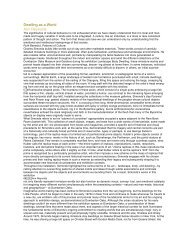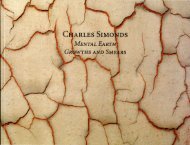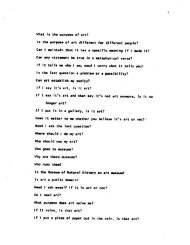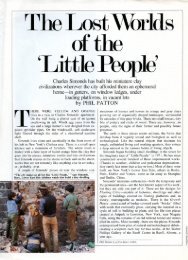Read Catalog - Charles Simonds
Read Catalog - Charles Simonds
Read Catalog - Charles Simonds
You also want an ePaper? Increase the reach of your titles
YUMPU automatically turns print PDFs into web optimized ePapers that Google loves.
On the Loose with the Little People:<br />
A Geography of <strong>Simonds</strong>'s Art<br />
By John Beardsley<br />
Much recent art has demonstrated a renewed preoccupation with landscape.<br />
Land art, sited sculpture, and certain kinds of performance have added to<br />
the traditional forms of landscape depiction in painting and photography<br />
a new level of involvement with the earth, its contours and materials. But<br />
even those new works most sensitive to their particular physical situations<br />
retain with the earth something of the conventional figure-ground relationship<br />
that characterizes images drawn on canvas or paper. While Robert<br />
Smithson's Spiral Jetty was generated by the topographic, geological, historic,<br />
and even mythological features of its landscape, 1 it is nevertheless quite apparently<br />
a mark on the ground. It reads as a drawing as much as a landscape<br />
element.<br />
<strong>Charles</strong> <strong>Simonds</strong> shares in the current preoccupation with landscape, yet in<br />
a way that begins to subvert the traditional figure-ground relationship. His<br />
work hypothesizes an identity between the landscape, the structures we build<br />
on it, and our bodies. Peripatetic, <strong>Simonds</strong> wanders the urban and natural<br />
landscapes of the world, musing, recording, testing his hypothesis. He observes<br />
the varying modes of our lives in different landscapes and the ways in<br />
which our social conventions, our architecture, and the evolution of our<br />
thought correspond to where we live. His works are the physical expression of<br />
these observations. In fantasy form, they tell us of the "Little People," of their<br />
migrations and their haltings, of their rituals and their beliefs. As the Little<br />
People move through a landscape, their beliefs and the forms of their architecture<br />
evolve, in part as a response to their physical surroundings. But these<br />
miniature landscapes and dwellings also reflect upon us. In encouraging us<br />
to contemplate the social and architectural structures of the Little People,<br />
<strong>Simonds</strong> makes us aware by comparison of the structures of our own lives.<br />
This comparison was perhaps most forcefully drawn in a piece that <strong>Simonds</strong><br />
executed on a rooftop at P.S. 1 in Queens in I97s(pl. s). Spread out behind the<br />
Figure ::1.. <strong>Charles</strong> <strong>Simonds</strong> working in Guilin, 1980.












